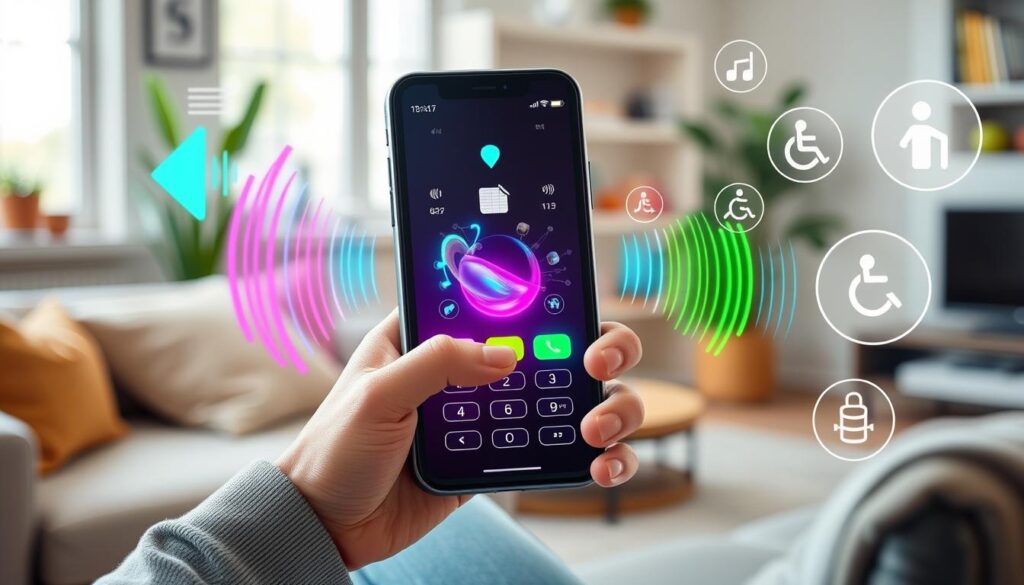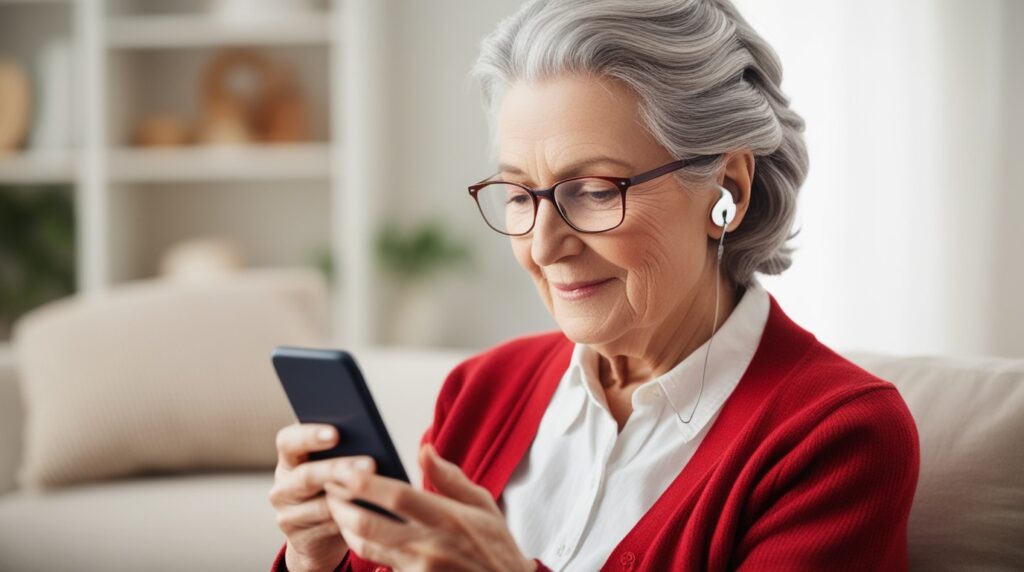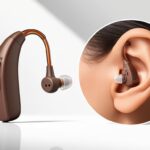Free Cell Phone for Hearing Impaired: How State Programs Offer Mobile Devices for Better Hearing. Additionally, if you’re dealing with tinnitus and other hearing-related issues, a solution promises no more whooshing, buzzing, or clicking sounds, and promotes better brain function. Learn more about this option here.
Key Takeaways
- State telephone equipment distribution programs offer free or low-cost assistive devices for the hearing impaired
- These programs provide a variety of accessible phones and communication tools, including amplified telephones, captioned phones, and TTY-compatible smartphones
- Eligibility is determined by individual state requirements, often based on proof of hearing loss or disability
- The programs aim to improve phone access and communication for those with hearing, vision, cognitive, mobility, and speech-related disabilities
- Services include a dual-party relay system and subsidized speech generating devices
Understanding State Telephone Equipment Distribution Programs
If you’re hearing-impaired in the United States, you might get free or discounted phones. These programs use money from phone bills to help. They give out captioned phones, amplified phones, and text phones to keep you connected.To address additional hearing concerns like tinnitus, explore a product designed to improve both hearing and brain function here.
The Hearing Loss Association of America (HLAA) looked into each state’s program. The rules for getting help vary. You need to meet income and hearing loss standards. A doctor’s note might be needed to prove this.
Eligibility Requirements and Coverage
Many states offer disability equipment loans through state-based telephone services programs. For example, Florida’s program gives free phones to those who qualify. You can get your phone through training, pickup, or group events.
- To qualify, you must be a permanent Florida resident, at least 3 years old, and certified as having a hearing or speech impairment by a qualified professional.
- The program covers a range of equipment, including captioned phones, amplified phones, and text telephones, all with battery backup for emergency situations.
- If you move within Florida, you can take the equipment with you after updating your address with FTRI. But, you can’t take it out of the state for more than 90 days.
Other states have similar programs. It’s important to check what’s available in your area. These telecom assistance programs can greatly improve your daily communication. They help you stay in touch with family and friends.Pairing these programs with a solution for tinnitus and other hearing challenges can offer a complete solution—learn more here.
Accessible Wireless Products and Services
There are many wireless options for people with hearing loss. The accesswireless.org website helps find phones with good hearing aid compatibility. It uses the Global Accessibility Reporting Initiative (GARI).
Many hearing aid compatible cell phones are now available. They have M4/T4 ratings for better performance with hearing aids. Also, speech-to-text mobile apps and video relay service phones help with communication.
The iPhone SE from Consumer Cellular has an M3/T4 rating. It also got a 4.5 rating from SeniorLiving.org for its ease of use. The Jitterbug Flip2 from Lively has an M4/T4 rating and a 4.5 rating too.If you’re seeking further hearing improvements, consider a solution that targets both hearing and brain function, available here.
Wireless service providers like Consumer Cellular offer affordable plans. Plans start at $20 for 1 GB of data and unlimited talk and text. This makes wireless technology more accessible for those with hearing loss.
“Over 100 hours were spent testing cell phones for seniors with hearing loss to find the top picks.”
Many seniors face hearing loss. The availability of hearing aid compatible cell phones, speech-to-text mobile apps, and video relay service phones improves communication. It also enhances their quality of life.
Captioned Telephone Services for Hearing Loss
For those with hearing loss, captioned telephone services are a big help. They work like captioned TV, showing real-time transcriptions of phone calls. This service is free, thanks to a federal program led by the Federal Communications Commission (FCC).
Reading Along as You Listen
Captioned phones connect users with a live assistant. This assistant uses speech recognition to write down what’s being said. The captions appear on the phone, letting users read and listen at the same time.Along with these tools, you might also benefit from a product that addresses tinnitus, offering a more complete hearing solution—explore it here.
This way, people with hearing loss can join in phone calls better. They can hear and see what’s being said, making conversations easier.
To get a captioned phone, you need to show you really need it. This rule makes sure the service goes to those who really need it, not just anyone.
Companies like CaptionCall, CapTel, and ClearCaptions offer these services. They have different phones, from landlines to mobile ones, for everyone’s needs.
“CaptionCall offers a no-cost service and phone for individuals with hearing loss who qualify.”
Captioned phones help people with hearing loss stay in touch. They can have deep conversations and keep their independence. By reading and listening together, they can overcome hearing barriers.
free cell phone for hearing impaired
If you or a loved one has hearing loss, you might get a free or low-cost cell phone. This is through your state’s Telecommunications Equipment Distribution Program (TEDP). These programs help people with disabilities like hearing loss, vision issues, and speech problems.
To qualify, you need to meet certain criteria. This includes your income, proof of hearing loss, and having a phone service. If you qualify, you can borrow the needed equipment. This includes amplified phones, volume-controlled devices, and text telephones (TTYs).
| Feature | Benefit |
|---|---|
| Free or low-cost cell phones and equipment | Provides essential communication tools for individuals with hearing loss and other disabilities |
| Long-term equipment loan program | Ensures ongoing access to vital communication resources |
| Eligibility based on income and hearing loss certification | Helps those who need it most access the necessary equipment |
These programs help individuals with hearing impairments stay connected, and when paired with solutions for tinnitus, the overall quality of life can greatly improve. Learn more about one such solution here.
Many states have a variety of disability equipment distribution options. This includes phones, amplifiers, and signaling devices for those with hearing impairments. By using these state telecom assistance programs, you can get the free amplified phones and tools you need. This helps you communicate better and improves your life quality.

“Hearing loss affects an estimated 30 million Americans, and nearly 25% of those aged 65 to 74 have disabling hearing loss. These state-run programs are a crucial resource for ensuring that individuals with hearing impairments have the communication tools they need to stay connected and engaged.”
Conclusion
There are many resources and programs available for people with hearing loss, highlighting the growing focus on accessibility. From assistive technology to free phones, these services ensure better communication for the hearing impaired. Additionally, advances in smartphone technology and apps have enhanced hearing health further.
These phones come with features such as adjustable volume, hearing aid compatibility, and text-to-speech capabilities. To qualify for these free or low-cost devices, you typically need to meet certain criteria such as income level and proof of hearing loss. Once approved, these programs provide the tools needed to improve your communication and overall well-being.
Finally, if you are also dealing with tinnitus or want to enhance your brain function while addressing hearing issues, there’s an innovative product designed just for that—learn more here.
Investing in both these state-run programs and a comprehensive hearing solution can significantly improve your communication and quality of life.
Check out This Post: https://healthsuccesful.com/choosing-the-right-ear-protection-for-concerts-and-events/
FAQ
What are Telecommunications Equipment Distribution Programs (TEDPs)?
TEDPs are state-run programs. They give out free or low-cost phone equipment. This is for people with hearing loss and other disabilities to help them use phones better.
What types of assistive devices are available through TEDPs?
TEDPs have many assistive devices. You can get amplified phones, captioned phones, and smartphones that work with TTY.
How are TEDPs funded and how do I qualify for them?
TEDPs get money from phone bill surcharges. They give out equipment on loan or with vouchers. You need to meet income and hearing loss rules to qualify. Each state has its own rules.
What accessible wireless products and services are available for individuals with hearing loss?
There are many accessible wireless products. This includes phones that work with hearing aids, apps that turn speech into text, and video phones. You can find and compare these on the accesswireless.org website.
How do captioned telephone services work?
Captioned phone services let people with hearing loss read what the other person is saying. A live assistant uses tech to write down the conversation as it happens.
Are there any free or low-cost cell phone options for individuals with hearing loss?
Yes, many states offer free or cheap cell phones and other equipment. You can get these through TEDPs. You need to meet income and hearing loss requirements, and have a phone service.
Source Links
- Phone For The Hearing Impaired | Hearing Impaired Phones – https://caconnect.org/hearing/
- Is there a way to get a free telephone for the deaf? – https://www.agingcare.com/questions/free-telephone-for-the-deaf-178100.htm
- Free Equipment Options for the Deaf and HoH in the US | Nagish – https://nagish.com/post/free-equipment-for-deaf-and-hoh
- Frequently Asked Questions – https://www.ftri.org/faq
- FTRI | CHChearing.org – https://www.chchearing.org/ftri
- State Telephone Programs – Telecommunications Equipment Distribution – https://www.hearingloss.org/hearing-help/financial-assistance/state-telephone-programs/
- Best Cell Phones for Hearing Impaired Seniors in 2024 – https://www.seniorliving.org/cell-phone/best/hearing-impaired/
- Best Caption Phones For Hearing Loss (With Free Options) – https://www.soundly.com/blog/best-caption-phones-hearing-loss
- Real-time Call Caption App | Android & Iphone | InnoCaption – https://www.innocaption.com/
- Free captioned telephone service for those with hearing loss – VA News – https://news.va.gov/86214/free-captioned-telephone-service-veterans-loved-ones-hearing-loss/
- Deaf or Hard of Hearing? Here’s How to Get a Free Caption Phone – https://www.thepennyhoarder.com/save-money/free-caption-phone/
- Deaf & Hard of Hearing Center – https://dhhc.life/ftri-free-phone-program
- Wireless Connectivity for People with Hearing Loss: Smartphones and Hearing Loss: There’s an App for That! – https://www.ncbi.nlm.nih.gov/pmc/articles/PMC7744170/
- Free Phones for Hearing Impaired: Bridging Communication Gaps – https://www.linkedin.com/pulse/free-phones-hearing-impaired-bridging-communication-gaps-enamul-haque-ngkkc



